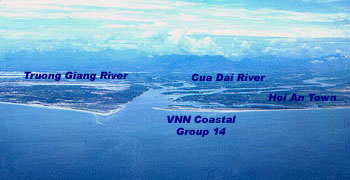
Entrance to the Cua Dai River
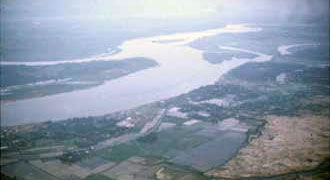
Hoi An Town from the air
 Entrance to the Cua Dai River |
 Hoi An Town from the air |
| All images on this page courtesy of Ray Ponthieux, Mark Bell, John Stevens, Sonny Barber, Gary Peterson and Ray Ballew |
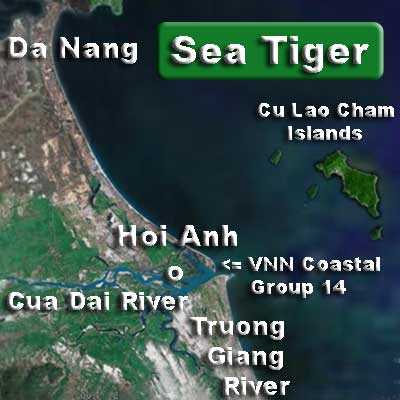 |
|
On September 27, 1967 Operation Green Wave was initiated with Task Force 116 Patrol Boat River (PBR) vessels in an attempt to control the Cua Dai River in I Corps. The PBR's were to be based from the USS Hunterdon County (LST-838) anchored at the river mouth and were to conduct river security patrols in this known enclave of VC activity. However, this force encountered such fierce resistance from the entrenched enemy forces around Hoi An, that just ten days later, on October 7, the operation was cancelled by its commander and the PBRs were sent back "home" to the Mekong Delta. The river in this free ranging enemy territory remained such a hostile waterway that it was considered unassailable by the allied commanders for the next year and a half. This situation changed dramatically as the SEALORDS campaign entered its second, or pacification, phase in early 1969. The following excerpt from the Stars and Stripes newspaper in the late spring of that year best explains what later came to be known as Operation Sea Tiger: |
|
About 2,000 years ago, Vietnamese fishermen were plagued by sharks who overturned their sampans and attacked the occupants. According to legend, a girl on a whale suggested that the fishermen paint eyes and teeth on the prows of their vessels for protection. The eyes must have worked. Today even the Vietnamese Navy Yabutas have them painted on their red prows, a design American Advisors are fond of calling the "screaming eagle." The Vietnamese Navy junks on the Cua Dai River, south of Da Nang, keep their "eyes" peeled. During recent months Coastal Group 14, the VNN base at the mouth of the river, has played a significant part in opening this waterway through regular patrols and raids on the Viet Cong installations on the shoreline. |
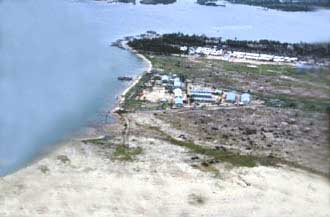 |
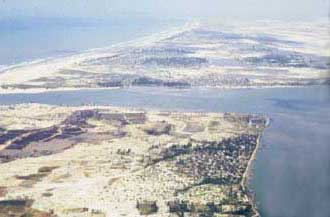 |
|
| Overhead view of VNN Coastal Group 14 | Entrance to the Cua Dai River | |
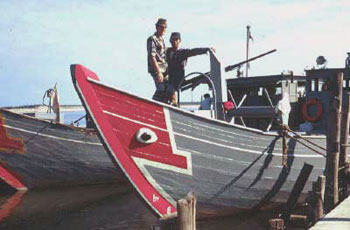 |
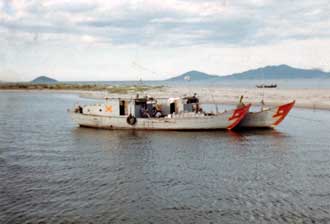 |
|
| VNN Sailor and US Advisor Jeffrey Morin ready for patrol | Two Yabutas anchored just off the Coastal Group 14 base |
Long a Viet Cong stronghold, the Cua Dai River area has been greatly pacified since February 1969 when VNN vessels and US Navy Swift Boats began regular patrols in the area. LT R. L. Andretta of Wheaton MD, Senior Advisor for the coastal group, says "We generally used to have an operation once a week around here, by inserting troops on the southern river bank to harass the VC." The base itself frequently received fire from that shore, and there had been a few attempts at ground attacks on the base from the nearby village of Doi. These days however, "Ambush Alley" - as the river is called - is often navigated without incident, although firefights are still very much a probability after dark. One former VC hideout is now a training center for Vietnamese Regional Forces. And further up the river, at Xuyen Long, a refugee camp has been established, primarily housing displaced Vietnamese civilians. Construction has already begun at the village's location which will ultimately replace the huts that are now used as homes for the refugees. As to the future of Coastal Group 14, LT Andretta says "I think when I leave here next February, I'll be able to water ski anywhere on the river whenever I please" |
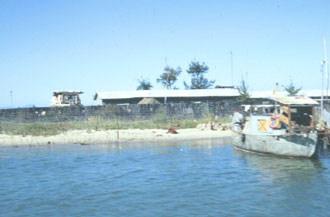 |
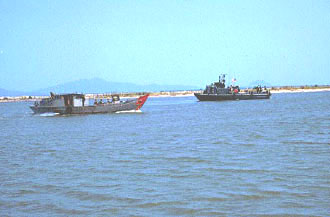 |
|
| Coast side approach to the Coastal Group 14 base | VNN Yabuta and Swift Boat at the Cua Dai River mouth |
In addition to the VNN Yabutas and VNN armed LCM (Mike) boats from Coastal Group 14, Swift Boats from Coastal Division 12, based in Da Nang, were also assigned to patrol the Cua Dai River starting in late February 1969. Two Swifts were assigned this duty in regular rotation of patrol duties that also included the normal coastal areas both north and south of Da Nang. But the river patrols were considered much more hazardous than the coastal areas, so boat assignments in this area were made to the more experienced crews who would be able to cope with the increased demands of this stressful environment. All Swift Boat patrols were twenty-four hours in length, on station. So the crews had to arise, prepare their boats, and get underway from Da Nang in the early morning hours in order to make the long transit south to the difficult entry into the river mouth and relieve the Swifts that had been on duty the previous day. |
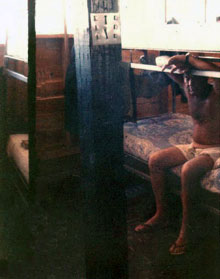 |
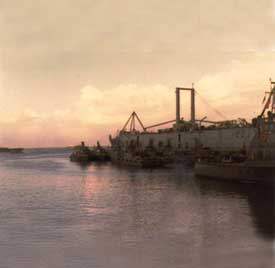 |
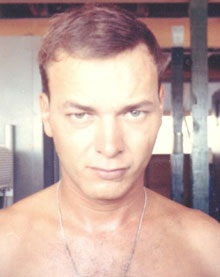 |
| !! REVEILLE !! REVEILLE !! !! Now all hands on deck !! |
Sunrise at Coastal Division 12 | Thousand Yard Stare !! OH NO - Not the Cua Dai AGAIN !! |
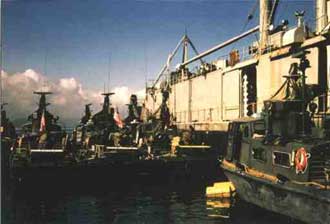 |
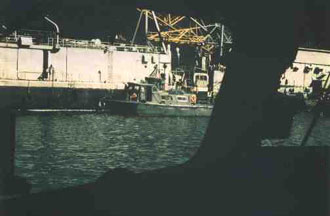 |
|
| Sleepy eyed crews board their boats | Getting underway for the transit to the Cua Dai | |
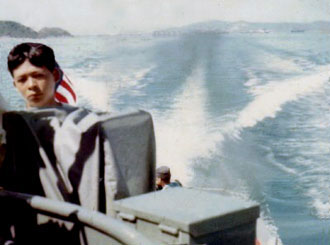 |
 |
|
| VNN Liaison on board and motivated | Headed south toward the entrance to the Cua Dai | |
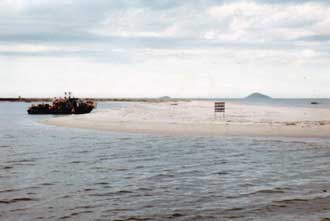 |
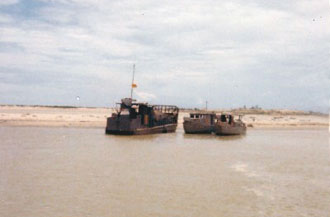 |
|
| Conference between relieving and relieved Swift Boat | VNN Yabutas and armed LCM also make a changeover |
Although the Vietnamese Yabuta and the US Swift Boat patrols were conducted separately, both extended inland on all three branches of the waterways that converged on Hoi An, the principal town in the area: the Main (or north) Cua Dai that meandered west past the dual bridges over the river; the Secondary (or south) Cua Dai that ran roughly parallel to the northern branch under a separate bridge of the north-south Highway One; and finally the Truong Giang River that departed the Cua Dai near its mouth and headed south parallel to, but inland from, the South China Sea coast. The patrols were always on the lookout to engage potential or actual hostile activities from the many bunkers lining the river bank. |
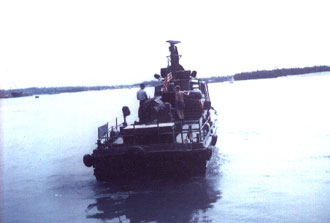 |
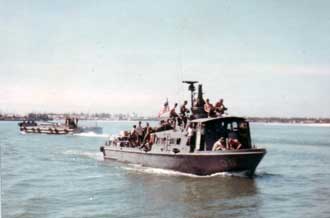 |
|
| Mark Bell's PCF-69 on the Cua Dai River | John Steven's PCF-39 passing an armed VNN LCM |
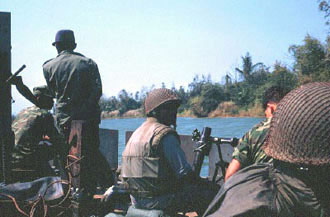 |
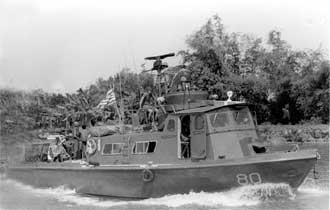 |
|
| View of a river patrol from a Yabuta | Ray Ballew's PCF-80 doing some trolling | |
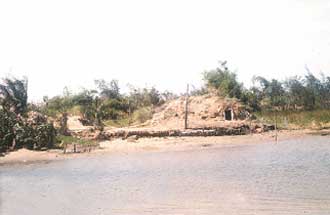 |
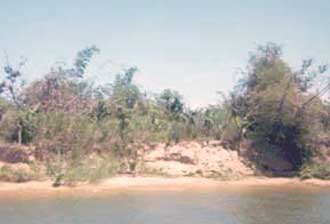 |
|
| Enemy bunker emplacement on the river bank | Another enemy bunker emplacement | |
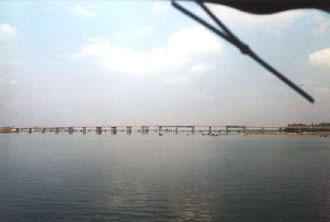 |
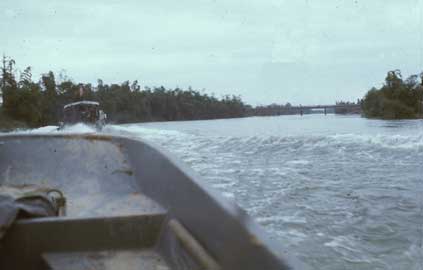 |
|
|
! A place guaranteed to receive hostile fire from ! |
! A place guaranteed to receive hostile fire from ! |
Initial patrol activity in February and March encountered significant problems from the North Vietnamese forces in control of the land areas on either side of the rivers, and also from unknown under water hazards in this area that had not seen active water borne traffic for some time. |
On 19 February 1969, PCF-55 and PCF-78 were sent on a probe to test the navigational limits of the southern branch of the river west of Hoi An. On the return trip PCF-78 discovered leftovers from the French era, as it struck an abandoned submerged vessel. The Swift flooded and sank in four feet of water. She was later refloated and towed back to Da Nang for repairs. | 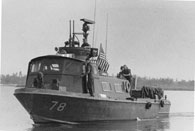 |
|
Then on March 19, PCF-101 and PCF-58 were attacked in "Ambush Alley" by enemy forces using a 75 MM Recoiless Rifle. The 101
was hit by two rounds from this heavy weapon. The first just aft of the pilot house and a second in the rear of the cabin
area which damaged the steering controls and also knocked the OinC and two other occupants of the boat over the side into
the river.
Fortunately, EN2 Ron Wood, manning the machine gun in the forward portion of the boat, was able to rush to the aft
steering station and kept the boat from running ashore directly in front of the attacking enemy. Wood also went to
the aid of his wounded shipmates, directed counter fire to distract the enemy and was instrumental in manuevering
the boat onto a nearby sandbank where all of the crewmen remaining aboard were rescued by other Swifts and Yabutas
that came to their rescue.
Ron was awarded the Silver Star for his heroic actions. |
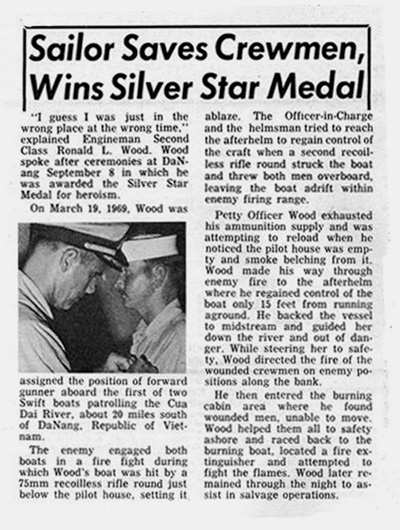
|
| Stars & Stripes article on Silver Star Award to R. L. Wood |
Interestingly, OinC Ensign Sonny Barber, QM2 Bill Pfeffer and Lt Bob Andretta (from Coastal Group 14), who were blown into the water, spent the night in abandoned enemy positions and hitched a ride back to the VNN coastal base the next morning on a passing fishing vessel |
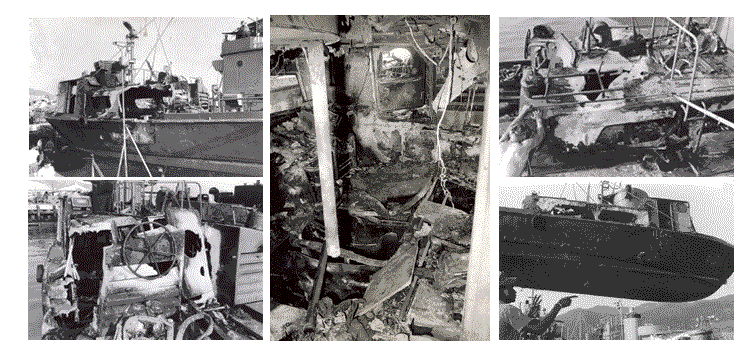 The 101 had to be sent back to Subic Bay for rebuild, but was back on line by July of 1969. |
| Read the narratives about this ambush by Sonny Barber and Gary Peterson |
|
Operating in pairs became the standard procedure for both Swift Boats and VNN Yabutas, which was the reason that two boats were normally assigned the Cua Dai area from Da Nang. At times, though, the Swift Boat assigned to the coastal patrol area just outside the Cua Dai would be called in to augment the other two boats when the situation so dictated. This was particularly true when the Swifts were tasked with insertion of Vietnamese land forces to conduct sweep operations adjacent to the river. |
 |
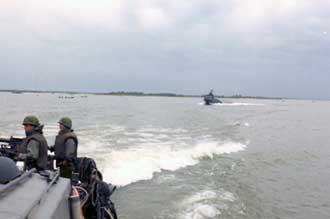 |
|
| Swifts and their infantry riders assemble | Enroute to the insertion point | |
 |
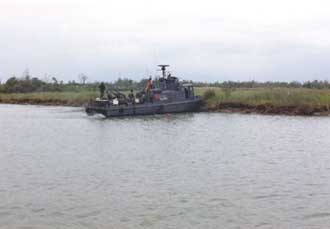 |
|
| One Swift covers another as it approaches the river bank | A Swift "nudges" the bank to let off the riders |
However, since the main thrust of Operation Sea Tiger was to clear and keep open the Cua Dai river for commercial and fishing activities, the typical role of monitoring and searching the water traffic on the rivers was a part of every patrol. |
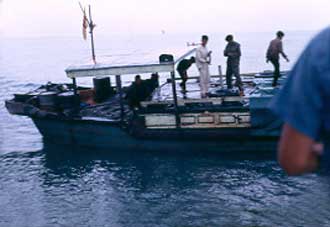 |
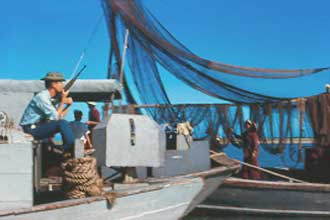 |
|
| Search of a commercial vessel near Hoi An | Searching a fishing vessel returning up river | |
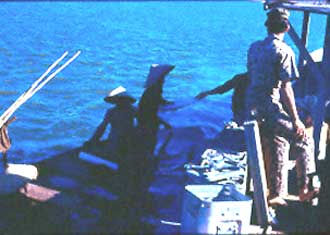 |
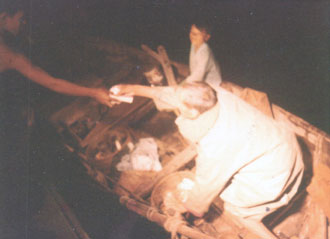 |
|
| Day time checks of river sampans were easy | Night time checks in the restricted zones were less easy | |
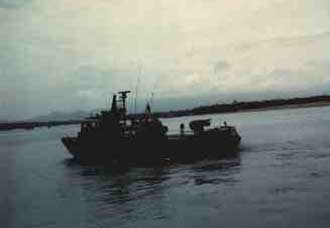 |
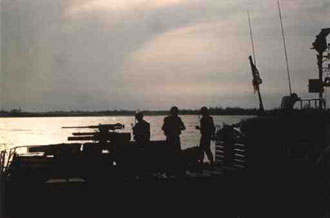 |
|
| Evening twilight on the river brought uncertainty | Better make another check that all weapons are ready |
But perhaps the most important utilization of the American and Vietnamese naval units was a significant involvement in more pro-active operations to pacify the land areas bordering the Cua Dai river waterways: Conducting Chieu Hoi (Open Arms) psychological activities to solicit North Vietnamese sympathizers to "rally" to the cause of the democratic South. The following two images show a result of one of these activities as a "Hoi Chanh," or Chieu Hoi Rallier, turns himself in to a Swift Boat crewman. See the Post Script for the pamphlets used in addition to speakers mounted on the naval vessels to broadcast messages to the VC soldiers on the river banks. |
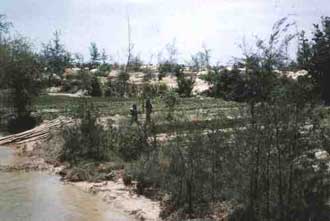 |
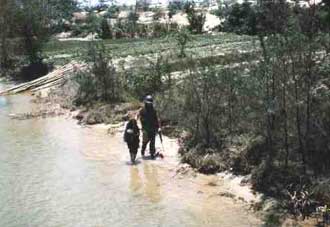 |
|
| Bringing a Hoi Chanh down to the river bank | A "Rallier to the Cause" is welcomed with "Open Arms" |
Both the psychological operations and more direct military operations had their effect on the stanglehold that the North Vietnamese forces held on the area. The following is a "Rogue's Gallery" of Hoi Chanhs, prisoners, weapons and other unfortunate enemy casualties resulting from Operation Sea Tiger between March and November of 1969. |
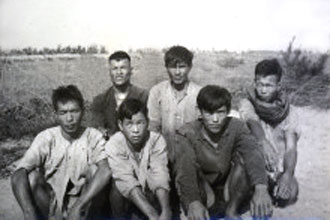 |
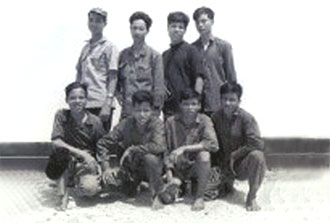 |
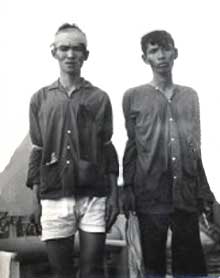 |
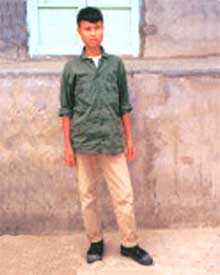 |
|
Prisoners are shown on the left, Hoi Chanhs are on the right The folks on the right certainly look much happier than those on the left |
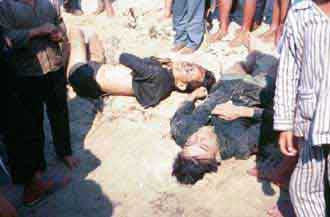 |
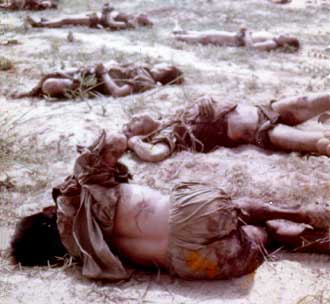 |
| Some North Vietnamese soldiers became statistics in neither the Hoi Chanh or POW categories |
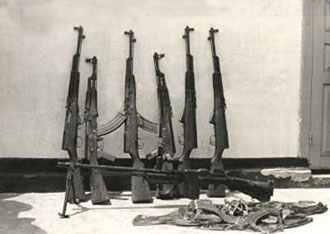 |
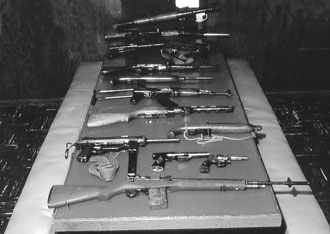 |
| Some of the weapons collected from the North Vietnamese soldiers above |
Not all of the activities of Operation Sea Tiger were strictly military ones. As the pacification efforts took hold, civil actions were undertaken to enhance the lives and living conditions of the residents of the areas around the rivers. The village of Doi, not far from Coastal Group 14, was a primary example of such humanitarian efforts. While the village had been under VC control, there had been numerous rocket, mortar and even ground attacks conducted against the VNN base at the mouth of the river. Once the area had been rendered safe for the population, American and Vietnamese sailors set about assisting the inhabitants to restore their village for a more normal and peaceful existence. |
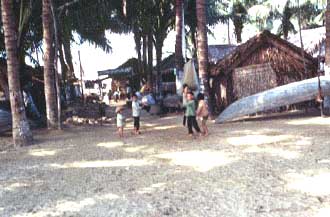 |
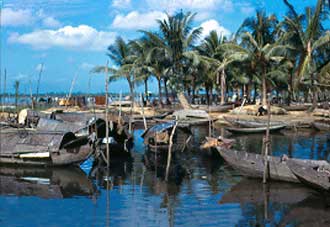 |
|
| Pacified Doi village not far from the VNN CG14 base | Fishing fleet anchored at Doi village | |
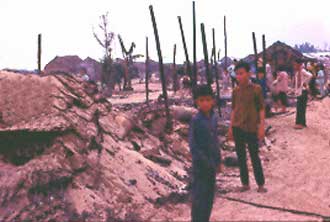 |
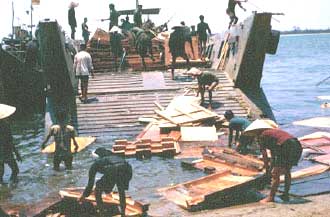 |
|
| Houses destroyed by the VC in Doi village |
"One man's left overs are another man's treasure" Supplying building materials to rebuild destroyed homes |
|
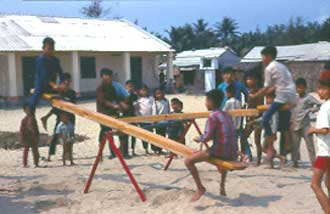 |
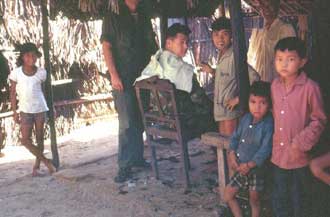 |
|
| Children's See Saw built by US Sailors | USN Advisor Steve Kozic gets a haircut in Doi village When a machine gun opened up across the river Steve beat a hasty retreat back to CG14 |
And further up river, at a refugee camp established at Xuan Long, Medical Civil Action Programs (MEDCAPs) were regularly conducted in addition to other activities to make the refugees lives more comfortable, safe and healthy. |
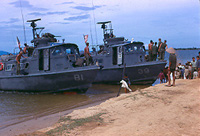 |
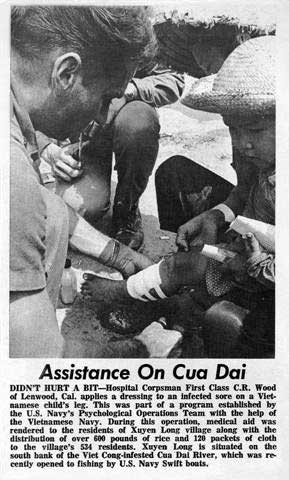 |
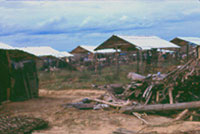 |
| MEDCAP at Xuan Long refugee camp |
By the spring of 1969, the South Vietnamese Government felt that operations on the Cua Dai had progressed sufficiently to hold a ceremony to make public to the people of the region that these waterways were open and safe to utilize for peaceful activities. Chief Petty Officer Ray Ponthieux participated in these proceedings as part of his assignment as the Naval Advisory Group PsyOps and Civic Action Advisor for I Corps. His entry for that day in the diary that he kept of his experiences reads: |
After several months of river patrol by Swift Boats and VN Navy junks, the rivers around Hoi An to the coast were declared open to commerce and fishing. Three Swift Boats and three VN Navy Yabutas departed CG-14 and slowly made their way up the north channel of the river to Hoi An. The junks broadcast Vietnamese music along the way. At Hoi An, they were met by Vietnamese officials and military personnel, U. S. Army Advisors and the Third Marine Amphibious Force Drum and Bugle Corps, who played the Vietnamese National Anthem and Anchors Aweigh. It was announced that by opening the river, it was now possible for the people of the area to use the river for fishing and commercial transportation. The trip up the river was uneventful. However, we took the south fork back to CG-14 and did receive machine gun and rocket fire on the way. There were no injuries to any of the boat crews. |
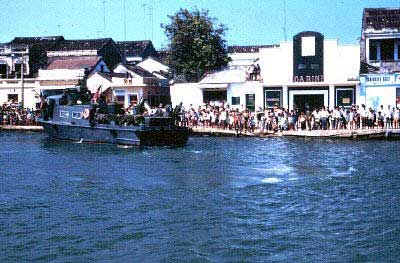 |
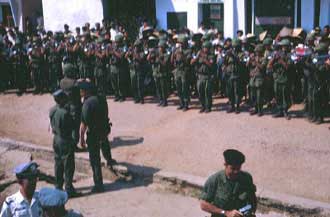 |
|
| Swift moored next to the crowds at the ceremony | USMC Drum and Bugle Corps provided inspirational music | |
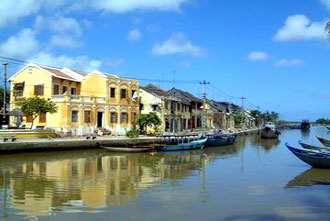 |
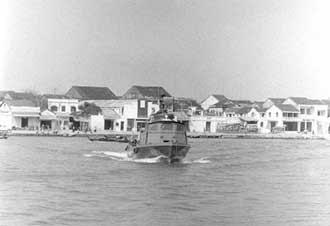 |
|
| The picturesque and now peaceful town of Hoi An | PCF 80 departs Hoi An to resume patrol | |
In November, the PCFs and VNN Yabutas were augmented by PBRs from Task Force Clearwater to allow penetration into areas too shallow for the Swift Boats. This also allowed redeployment of the Coastal Division 12 assets to other areas of SEALORDSoperations, specifically in the Mekong Delta region. |
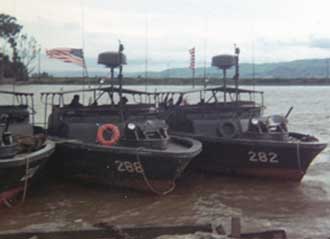 |
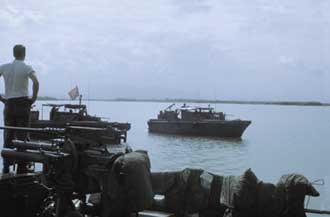 |
Over the next several months, the US Navy presence in I Corps was significantly reduced as the Vietnamization program became fully implemented. All of the US Swift patrols on the Cua Dai had been discontinued by December, and CosDiv 12 was disestablished, with all its boats turned over to the Vietnamese Navy, on February 28, 1970. |
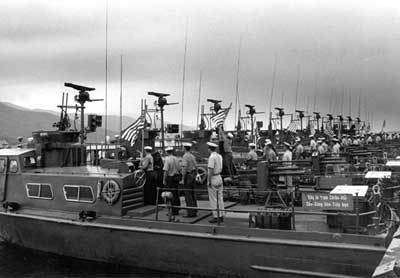
|
| Sea Tiger was turned over to the VNN at the end of May 1970 and renamed Tran Hung Dao VII |
| All Units participating in Operation Sea Tiger {Task Group 115.1} were awarded the Meritorious Unit Commendation |
This Psychological Warfare pamphlet provides instructions to those enemy soldiers wishing to be welcomed with "Open Arms" by the Government of South Vietnam:
Also, each Swift Boat carried a sign on the port and starboard railings of the fantail that said in Vietnamese {paraphrased):
Announcement about the Chieu Hoi Program
|
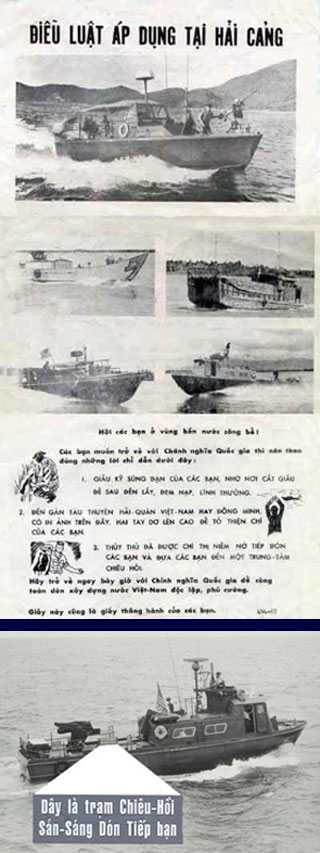 |
|
| Read a complete discussion of the The Chieu Hoi Program by SGM Herbert A. Friedman (Ret.) |
This web site is Copyright � 2002 by Robert B. Shirley. All rights reserved. Click on image to return to the homepage
|